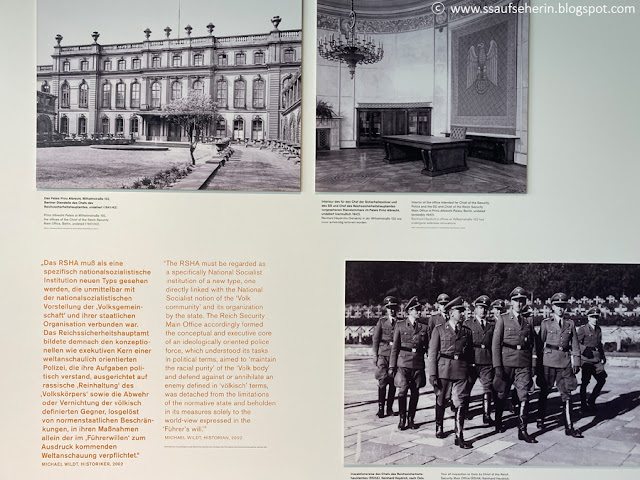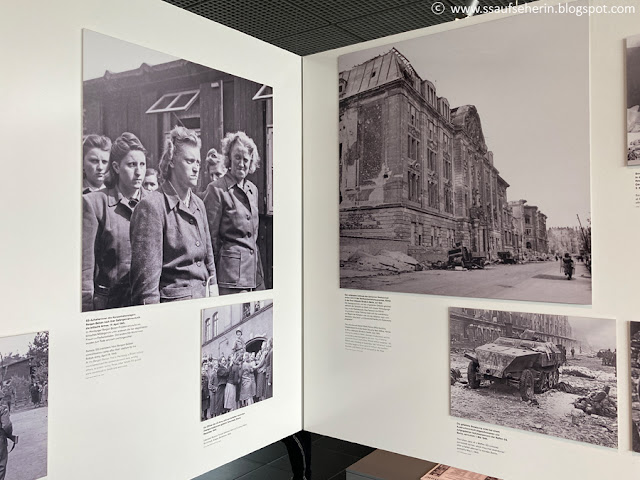Berlin historycznie: Muzeum "Topografia terroru"

Sites of Remembrance 1933-1945
Memorial sites, documentation centres and museums concerning the history of the national socialist dictatorship in Berlin and Brandenburg
These institutions are public places of learning which offer a wide selection of political education opportunities to individuals and groups, young people and adults; including many diverse ways in which to learn about the victims and the perpetrators. The memorial sites, documentation centres and historical museums are considered to be places of remembrance which assist in the advancement of a tolerant and democratic society.
TOPOGRAPHY OF TERROR
"Topography of Terror" - this is the present-day name of the site on which the most important institutions of the Nazi apparatus of terror and persecution were located between 1933 and 1945: the headquarters of the Secret State Police (Gestapo), the Reich SS Leadership and Security Service (SD) of the SS and, from 1939 on, the Reich Security Main Office.
The bildings, which were partly destroyed and partly damaged in the final phase of the war, were demolished in the years up to 1956. The history of the site was forgotten, and only gradually reentered public awareness in the late 1970s.
In 1987 a documentation of the site was set up, which since then has informed visitors about the site's history and the crimes that were planned and initated here. The opening of the new documentation center in May 2010 brings to an end more than twenty years of makeshift quarters, and finally allows the Topography of Terror Foundation to realize its mandate fully: to convey historical information on Nazi terror and inspire visitors to engage actively with this history and its consequences after 1945.
The German- and English- language permanent exhibition "Topography of Terror: Gestapo, SS, and Reich Security Main Office on Wihelm- and Prinz-Albrecht-Strasse" focuses on the central institutions of the SS and the police during the "Third Reich" as well as the crimes they committed across Europe. In addition to presenting the perpetrators' system of terror, the exhibition also draws attention to the various groups of victims targeted by the Nazi regime.
A site tour in 15 stations offers an overview of the history of the site now occupied by the "Topography of Terror", its use during the Nazi period and the postwar era, and an introduction to the institutions of Nazi terror that were located here under the "Third Reich".
The documentation "Berlin 1933-1945. Zwischen Propaganda und Terror" elucidates Berlin's historical role as capital of the Third Reich. It will be presented in the exhibition trench along the excavated remains of the cellar walls on Niederkirchnerstrasse. Above the trench is the longest remaining continuous piece of the Wall in central Berlin.
The library currently holds some 27,000 volumes on National Socialism. It is open to the public Monday through Friday from 10 a.m. to 5 p.m.
The Topography of Terror Foundation's lecture and film events take place in the auditorium, which can accommodate about 200 people.
Topography of Terror
Niederkirchnerstrasse 8
10963 Berlin
*
W samym centrum Berlina znajduje się wyjątkowe muzeum - "Topografia Terroru". Nietrudno zgadnąć o jaki terror tu chodzi. Osoby interesujące się tematyką Holokaustu z pewnością będą chciały to miejsce zwiedzić. Nie jest to typowe muzeum z dużą ilością archiwalnych obiektów, bardziej przypomina rozbudowaną informację tekstowo-obrazkową o szeroko pojętej historii niemieckiego nazizmu. Osoby, które interesują się Zagładą lub przeszłością Trzeciej Rzeszy nie znajdą tutaj jednak niczego nowego - to przekrojowa wystawa skierowana raczej do przeciętnego turysty chcącego zobaczyć i przeczytać coś na szybko o nazistowskich Niemczech - w końcu Berlin był stolicą tego państwa i to jak najbardziej adekwatne miejsce na stworzenie takiego muzeum. Na obejrzenie całej wystawy - tej wewnątrz budynku oraz na zewnątrz trzeba zarezerwować około trzech godzin. Wstęp jest bezpłatny.
Dodatkowym atutem jest nazistowska przeszłość samego obszaru wokół dzisiejszego muzeum "Topografii Terroru". Otóż w latach 30. po dojściu Hitlera do władzy to właśnie przy ulicy Prinz-Albrecht-Strasse 8 zlokalizowana była kwatera główna Tajnej Policji Państwowej czyli Gestapo, Główny Urząd Bezpieczeństwa Rzeszy oraz biura SS. Ogromny bogato zdobiony budynek przed wojną mieścił wnętrza Szkoły Sztuki Przemysłowej i Rzemiosła. Jednak jak się okazało po 1933 roku, największą sztuką nazistowskich Niemiec było zastraszanie ludzi i sianie ogólnospołecznego terroru wśród mieszkańców Berlina. W podziemiach budynku przy ulicy Prinz-Albrecht Strasse 8 znajdowały się także cele więzienne, w których przetrzymywano osoby podejrzane o antyhitlerowską działalność. Tuż obok dzisiejszego muzeum "Topografii Terroru" można zobaczyć zachowany w doskonałym stanie monumentalny budynek dawnego Ministerstwa Lotnictwa Rzeszy (dziś Ministerstwa Finansów), w którym swoje biuro miał Hermann Göring. Podsumowując: była to taka rządowa dzielnica, gdzie rozlokowano wszystkie najważniejsze placówki rządowe. Bardzo ciekawie prezentują się makiety pokazujące wygląd dzielnicy rządowej w Berlinie w drugiej połowie lat 30. - można dokładnie przestudiować rozmieszczenie budynków i konkretnych placówek.
To muzeum może być takim dobrym punktem wyjścia do dalszego zwiedzania przeszłości "wojennego" Berlina. Po zapoznaniu się z "Topografią Terroru", można ruszyć ku następnym placówkom: Miejsca Pamięci Niemieckiego Ruchu Oporu oraz Domu Konferencji w Wannsee. Podczas ostatniego pobytu w Berlinie specjalnie dla moich Czytelników odwiedziłam wszystkie te muzea i zrobiłam dokumentację fotograficzną! Zapraszam więc na wspólne zwiedzanie!
Zdjęcia zrobiłam w sierpniu 2020.


























Komentarze
Prześlij komentarz